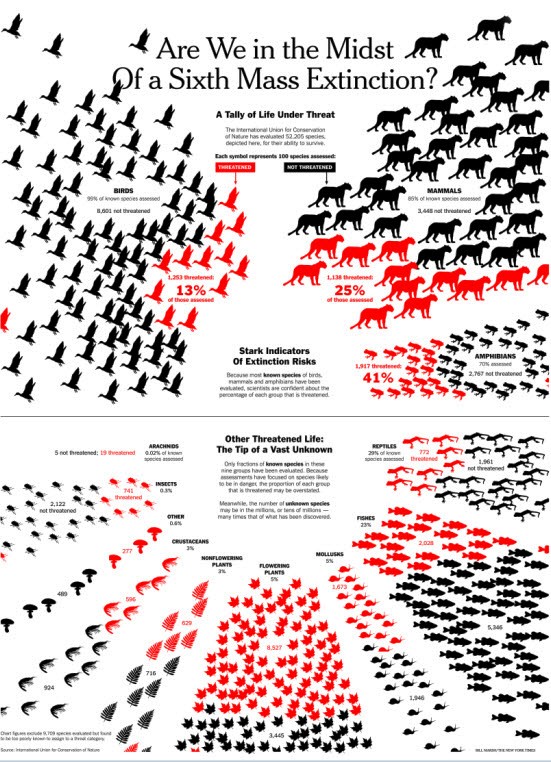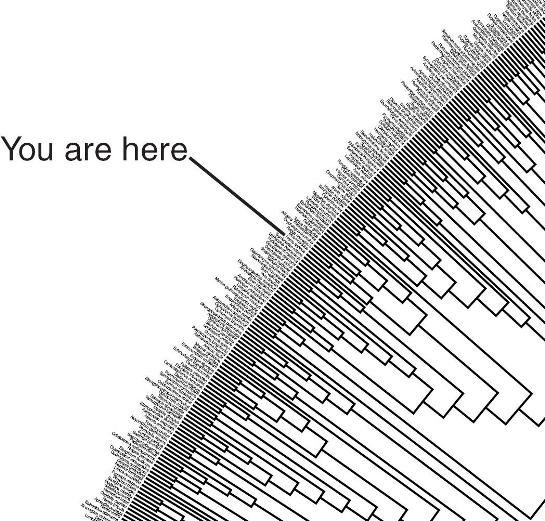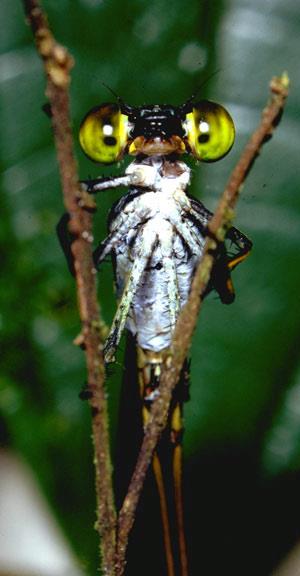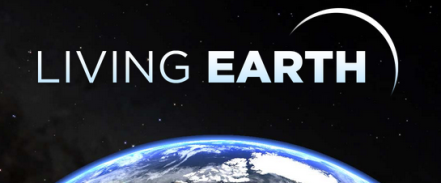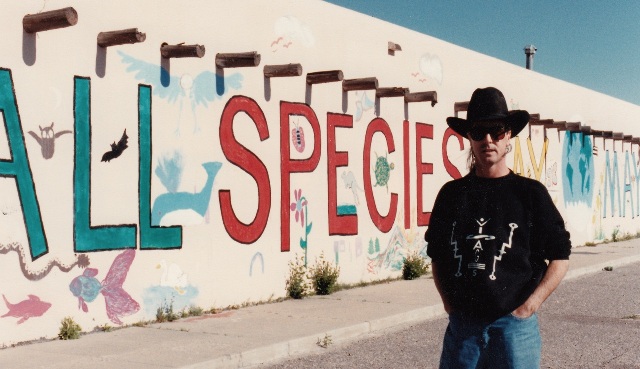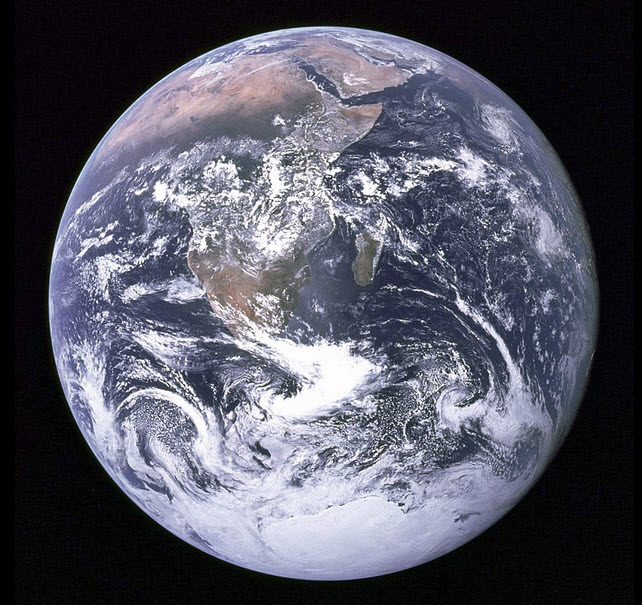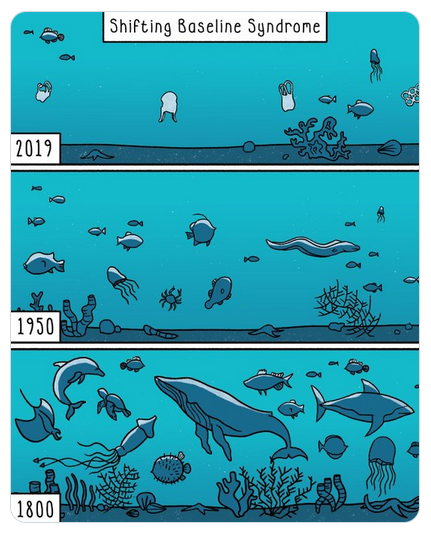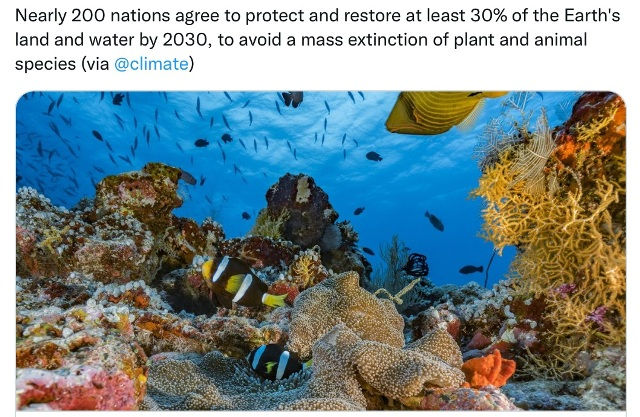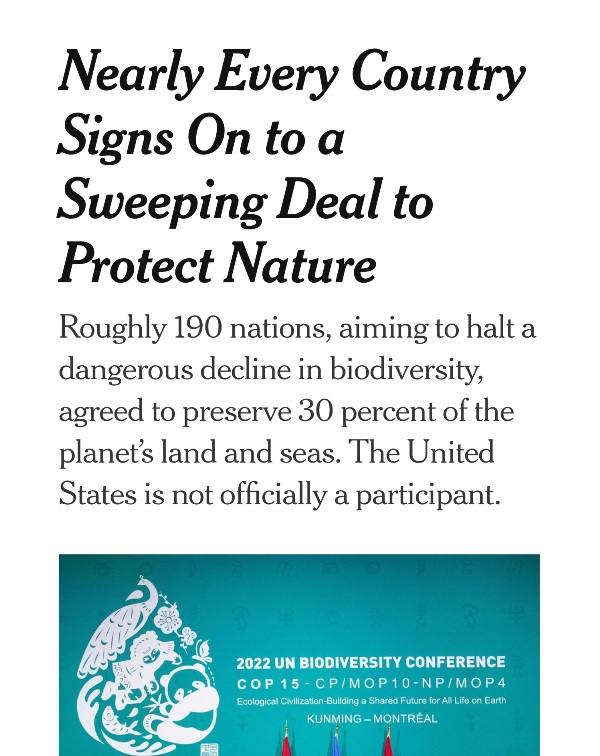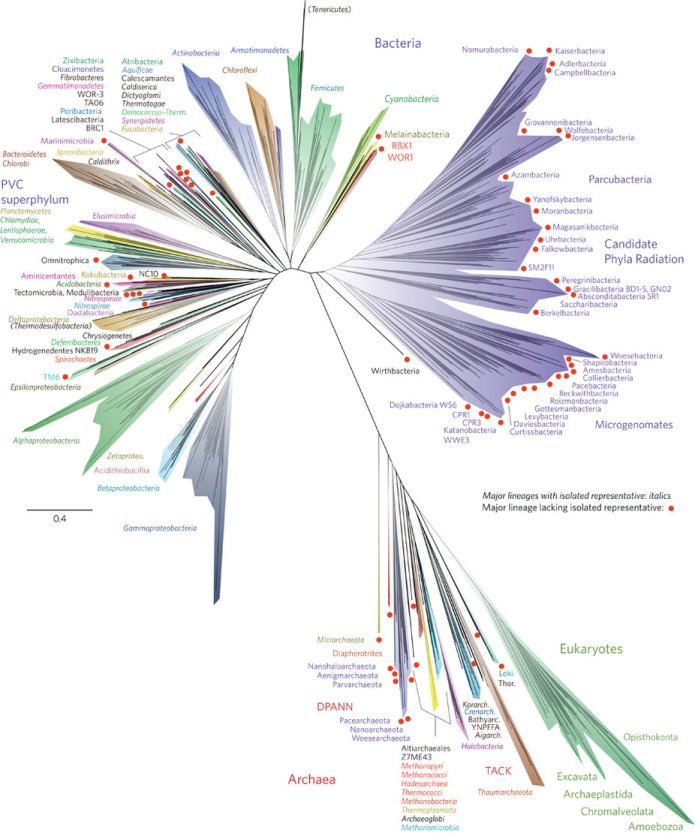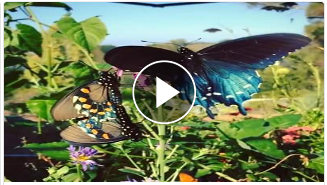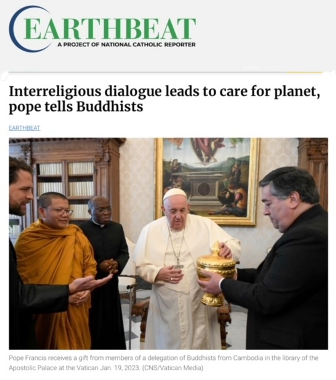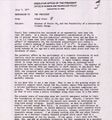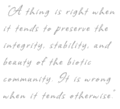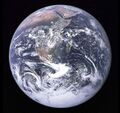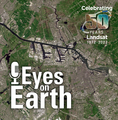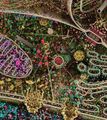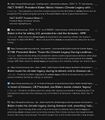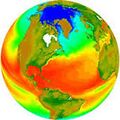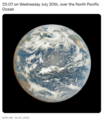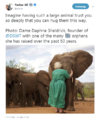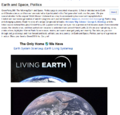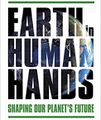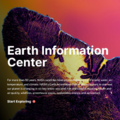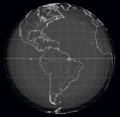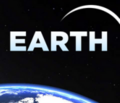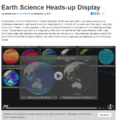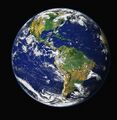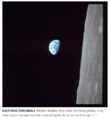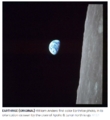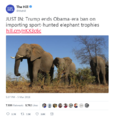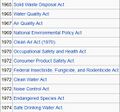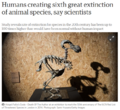Category:Biodiversity: Difference between revisions
Siterunner (talk | contribs) No edit summary |
Siterunner (talk | contribs) No edit summary |
||
| (85 intermediate revisions by the same user not shown) | |||
| Line 1: | Line 1: | ||
<big><big><big>'''Crisis of LIfe'''</big></big></big> | |||
[https://s3.amazonaws.com/wwfassets/downloads/lpr2018_summary_report_spreads.pdf <big><big>'''Living Planet Report | : <big><big>'''Biodiversity Crisis'''</big></big> | ||
The biomass of terrestrial vegetation worldwide has halved over human history 3, with a corresponding loss of more than 20% of this realm’s original biodiversity (References follow) 1. | |||
More than 70% of the Earth’s land surface has been altered by humans 1. | |||
There have been over 700 vertebrate 1, and nearly 600 plant 4, extinctions recorded since the 16th Century, and many more species have likely gone extinct unnoticed 5. | |||
Massive population declines that are the precursors to extinction have also occurred worldwide; since only 1970, more than 60% of all terrestrial vertebrate individuals have disappeared 6, such that there are now at least one million species threatened with extinction6 out of an estimated 7.3 – 10.0 million eukaryotic species on the planet 7. | |||
The total global biomass of wild animals today is < 25% of what it was during the Late Pleistocene8, and even insect species appear to be in rapid decline in many parts of the world 9-13. | |||
There is now less than 15% of the original wetland area that was present during the 18th Century 14, and over three-quarters of rivers more than 1000 km long no longer flow freely along their entire course 15. | |||
Over two-thirds of ocean area has been compromised to some extent by human endeavour 16 | |||
Live coral cover on reefs has halved since the mid-19th Century 17, seagrass extent has been decreasing by 10% per decade over the last century 1, kelp forests have declined by nearly 40%18, and the biomass of large predatory fishes is now less than a third of what it was last century 19. | |||
Of the estimated 0.17 Gt of biomass of terrestrial vertebrates on Earth today, most of this is represented by livestock (59%) and living human beings (36%) — only about 5% of this total biomass is taken up by wild mammals, birds, reptiles and amphibians8. | |||
Even our domesticated species are in decline — some 10% of domesticated breeds of mammals have become extinct in human history, with more than 1000 others threatened with extinction 20 | |||
Even cultivated plants are becoming threatened, with about 200 cultivated species threatened with extinction 21, and a global homogenisation of food crop species used to feed the world over the last 50 years 22. | |||
'''All this means that we are now without a doubt well within a sixth mass extinction event.''' | |||
[[File:Sixth Mass Extinction Infograph-NYT - 2.jpg]] | |||
'''Endangered species''' | |||
* https://www.greenpolicy360.net/w/Endangered_species | |||
'''Extinction''' | |||
* https://www.greenpolicy360.net/w/Extinction | |||
Next time someone you know argues that the natural world isn’t that poorly off, you can show them this rather depressing list of facts to the contrary. -- CJA Bradshaw | |||
* https://conservationbytes.com/2020/01/24/the-state-of-global-biodiversity-its-worse-than-you-probably-think/ | |||
References: | |||
1. Díaz et al. Pervasive human-driven decline of life on Earth points to the need for transformative change. Science 366, eaax3100 (2019) | |||
2. Intergovernmental Science-Policy Platform on Biodiversity and Ecosystem Services. Global Assessment Report on Biodiversity and Ecosystem Services. (IPBES Secretariat, Paris, France, 2019) | |||
3. Erb et al. Unexpectedly large impact of forest management and grazing on global vegetation biomass. Nature 553, 73-76 (2018) | |||
4. Humphreys et al. Global dataset shows geography and life form predict modern plant extinction and rediscovery. Nat. Ecol. Evol. 3, 1043-1047 (2019) | |||
5. Tedesco et al. Estimating how many undescribed species have gone extinct. Conserv. Biol. 28, 1360-1370 (2014) | |||
6. WWF. Living Planet Report 2016. (WWF, Gland, Switzerland, 2016) | |||
7. Mora et al. How many species are there on Earth and in the ocean? PLoS Biol. 9, e1001127 (2011) | |||
8. Bar-On et al. The biomass distribution on Earth. Proc. Natl. Acad. Sci. USA 115, 6506 (2018) | |||
9. Bidau. Doomsday for insects? The alarming decline of insect populations around the world. Entomol. Ornithol. Herpetol. 7, 1000e1130 (2018) | |||
10. Hallmann et al. More than 75 percent decline over 27 years in total flying insect biomass in protected areas. PLoS One 12, e0185809 (2017) | |||
11. Lister & Garcia. Climate-driven declines in arthropod abundance restructure a rainforest food web. Proc. Natl. Acad. Sci. USA 115, E10397 (2018) | |||
12. Powney et al. Widespread losses of pollinating insects in Britain. Nat. Comm. 10, 1018 (2019) | |||
13.Forister et al. Declines in insect abundance and diversity: we know enough to act now. Conserv. Sci. Pract. 1, e80 (2019) | |||
14. Davidson. How much wetland has the world lost? Long-term and recent trends in global wetland area. Mar. Freshw. Res. 65, 934-941 (2014) | |||
15. Grill et al. Mapping the world’s free-flowing rivers. Nature 569, 215-221 (2019) | |||
16. Halpern et al. Patterns and emerging trends in global ocean health. PLoS One 10, e0117863 (2015) | |||
17. Frieler et al. Limiting global warming to 2 °C is unlikely to save most coral reefs. Nat. Clim. Change 3, 165-170 (2013) | |||
18. Krumhansl et al. Global patterns of kelp forest change over the past half-century. Proc. Natl. Acad. Sci. USA 113, 13785 (2016) | |||
19. Christensen et al. A century of fish biomass decline in the ocean. Mar. Ecol. Prog. Ser. 512, 155-166 (2014) | |||
20. FAO. The State of the World’s Animal Genetic Resources for Food and Agriculture. (Food and Agriculture Organization of the United Nations, Rome, Italy, 2016) | |||
21. Hammer & Khoshbakht. Towards a ‘red list’ for crop plant species. Genet. Resour. Crop Evol. 52, 249-265 (2005) | |||
22. Khoury et al. Increasing homogeneity in global food supplies and the implications for food security. Proc. Natl. Acad. Sci. USA 111, 4001 (2014) | |||
········································· | |||
<big><big>'''Earth is in our hands'''</big></big> | |||
: Humanity must act to nurture, preserve & protect life on Earth | |||
:[[File:Earth in Human Hands.jpg]] | |||
::[http://www.planetcitizen.org <big><big><big>'''Planet Citizens'''</big></big></big>] | |||
[[File:You are here on the cladogenetic tree m.jpg]] | |||
········································· | |||
<big><big>'''The Hidden Universe'''</big></big> | |||
* https://www.amazon.com/Hidden-Universe-Adventures-Biodiversity/dp/0226821870 | |||
[[File:The Hidden Universe - Adventures in Biodiversity.png]] | |||
········································· | |||
[http://asknature.org <big><big><font color=green>Nature is sending a message --- "Act Now to Protect the Living Earth Before It's Too Late"</font></big></big>] | |||
<big>'''A Generational Challenge:'''</big> | |||
:'''Act Now to Protect Biodiversity, Life on Earth''' | |||
:[[File:Bug eyes in the rainforest canopy Photo by Don Perry-2.jpg]] | |||
:[https://www.greenpolicy360.net/w/File:Bug_eyes_in_the_rainforest_canopy_Photo_by_Don_Perry-2.jpg <small>''''Bug Eyes' says now is the 'Time to Open Your Eyes''''</small>] | |||
🌎 | |||
[[File:Living Earth.png]] | |||
With your GreenPolicy Siterunner in Santa Fe circa 1989 on [https://www.greenpolicy360.net/w/All_Species_Day '''All Species Day''']. Looking back and looking forward to the challenges of affirming and protecting diversity of life in the midst of the [http://www.greenpolicy360.net/w/Extinction '''"Sixth Extinction"'''] | |||
:Santa Fe ('holy faith' in Spanish) named in memory of the 'holy faith of St. Francis of Assisi', a patron saint of animals and the environment. | |||
:::[[File:All species day with homo sapien in Santa Fe .jpg]] | |||
| |||
<big><big>'''''2023'''''</big></big> | |||
[https://overpopulation-project.com/wp-content/uploads/2023/01/Cafaro-et-al.-Bibliography-of-recent-scientific-work-on-population-and-biodiversity-conservation-2023.pdf <big>'''Human Population and the Loss of Biodiversity'''</big>] | |||
[https://overpopulation-project.com/wp-content/uploads/2023/01/Cafaro-et-al.-Bibliography-of-recent-scientific-work-on-population-and-biodiversity-conservation-2023.pdf ''A Bibliography of Recent Scientific Work on Population and Biodiversity Conservation''] | |||
"Overpopulation is a major cause of biodiversity loss and smaller human populations are necessary to preserve what is left." | |||
Entries include publication data, a hot link to the source, and a one-sentence description. | |||
🌎 | |||
<big><big>'''''Earth is in midst of a 'Sixth Mass Extinction' with wildlife on Earth running out of places to live'''''</big></big> | |||
'''''60 Minutes / CBS / January 1, 2023''''' | |||
* https://www.cbsnews.com/news/earth-mass-extinction-60-minutes-2023-01-01/ | |||
* https://www.greenpolicy360.net/w/File:Sixth_Mass_Extinction_infograph-NYT.jpg | |||
''In what year will the human population grow too large for the Earth to sustain? The answer is about 1970, according to research by the World Wildlife Fund. In 1970, the planet's 3 and a half billion people were sustainable. But on this New Year's Day, the population is 8 billion. Today, wild plants and animals are running out of places to live. The scientists you're about to meet say the Earth is suffering a crisis of mass extinction on a scale unseen since the dinosaurs. We're going to show you a possible solution, but first, have a look at how humanity is already suffering from the vanishing wild.'' | |||
''In Washington state, the Salish Sea helped feed the world.'' | |||
''Dana Wilson: With this weather and the way things feel once I get out here, it's time to be fishing, that's what it feels like.'' | |||
''Commercial fisherman Dana Wilson supported a family on the Salish Sea's legendary wealth of salmon. He remembers propellers churning the water off blaine, washington and cranes straining for the state's 200 million dollar annual catch.'' | |||
''Dana Wilson: That used to be a buying station, they're gone now, they don't buy anymore. So, that building over there used to buy salmon, they don't buy salmon anymore, it's just not here.'' | |||
''In 1991, one salmon species was endangered. Today, 14 salmon populations are foundering. They've been crowded out of rivers by habitat destruction, warming, and pollution. Dana Wilson used to fish all summer. Today, a conservation authority grants rare, fleeting, permission to throw a net.'' | |||
''Scott Pelley: There was a season.'' | |||
''Dana Wilson: There was a season.'' | |||
''Scott Pelley: Now there's a day?'' | |||
''Dana Wilson: There's a day, and sometimes it's hours. Sometimes you might get 12 hours, 16 hours. that's what we're down to.'' | |||
<more> | |||
'''''Too many people, too much consumption and growth mania.''''' | |||
''At the age of 90, biologist Paul Ehrlich may have lived long enough to see some of his dire prophecies come true.'' | |||
''Scott Pelley: You seem to be saying that humanity is not sustainable?'' | |||
''Paul Ehrlich: Oh, humanity is not sustainable. To maintain our lifestyle (yours and mine, basically) for the entire planet, you'd need five more Earths. Not clear where they're gonna come from.'' | |||
''Scott Pelley: Just in terms of the resources that would be required?'' | |||
''Paul Ehrlich: Resources that would be required, the systems that support our lives, which of course are the biodiversity that we're wiping out. Humanity is very busily sitting on a limb that we're sawing off.'' | |||
''In 1968, Ehrlich, a biology professor at Stanford, became a doomsday celebrity with a bestseller forecasting the collapse of nature.'' | |||
''Scott Pelley: When "The Population Bomb" came out, you were described as an alarmist.'' | |||
''Paul Ehrlich: I was alarmed. I am still alarmed. All of my colleagues are alarmed.'' | |||
''The alarm Ehrlich sounded in '68 warned that overpopulation would trigger widespread famine. He was wrong about that. The green revolution fed the world. But he also wrote in '68 that heat from greenhouse gases would melt polar ice and humanity would overwhelm the wild. Today, humans have taken over 70% of the planet's land and 70% of the freshwater.'' | |||
''Paul Ehrlich: The rate of extinction is extraordinarily high now and getting higher all the time.'' | |||
''We know the rate of extinction is 'extraordinarily high' because of a study of the fossil record by biologist Tony Barnosky, Ehrlich's Stanford colleague. '' | |||
''Tony Barnosky: The data are rock solid. I don't think you'll find a scientist that will say we're not in an extinction crisis.'' | |||
''Barnosky's research suggests today's rate of extinction is up to 100 times faster than is typical in the nearly 4 billion year history of life. These peaks represent the few times that life collapsed globally. And the last was the dinosaurs, 66 million years ago.'' | |||
''Tony Barnosky: There are five times in Earth's history where we had mass extinctions. And by mass extinctions, I mean at least 75%, three quarters of the known species disappearing from the face of the Earth. Now we're witnessing what a lot of people are calling the sixth mass extinction where the same thing could happen on our watch.'' | |||
<more> | |||
''Scott Pelley: Is it too much to say that we're killing the planet?'' | |||
''Liz Hadly: No.'' | |||
''Tony Barnosky: I would say it is too much to say that we're killing the planet, because the planet's gonna be fine. What we're doing is we're killing our way of life.'' | |||
''The worst of the killing is in Latin America where the World Wildlife Fund study says the abundance of wildlife has fallen 94% since 1970. But it was also in Latin America that we found the possibility of hope.'' | |||
''Mexican ecologist Gerardo Ceballos is one of the world's leading scientists on extinction. He told us the only solution is to save the one third of the Earth that remains wild....'' | |||
''Gerardo Ceballos: What we will have to do is to really understand that the climate change and the species extinction is a threat to humanity. And then put all the machinery of society: political, economic, and social, towards finding solutions to the problems.'' | |||
''Finding solutions to the problems was the goal, two weeks ago, at the U.N. Biodiversity Conference, where nations agreed to conservation targets. But at the same meeting in 2010, those nations agreed to limit the destruction of the Earth by 2020—and not one of those goals was met. This, despite thousands of studies including the continuing research of Stanford biologist Paul Ehrlich.'' | |||
''Scott Pelley: You know that there is no political will to do any of the things that you're recommending.'' | |||
''Paul Ehrlich: I know there's no political will to do any of the things that I'm concerned with, which is exactly why I and the vast majority of my colleagues think we've had it; that the next few decades will be the end of the kind of civilization we're used to.'' | |||
''In the 50 years since Ehrlich's population bomb, humanity's feasting on resources has tripled. We're already consuming 175% of what the Earth can regenerate. And, consider, half of humanity, about four billion, live on less than $10 a day. They aspire to cars, air conditioning and a rich diet....'' | |||
''The five mass extinctions of the ancient past were caused by natural calamities—volcanoes, and an asteroid. Today, if the science is right, humanity may have to survive a sixth mass extinction in a world of its own making.'' | |||
·············································································· | |||
<big><big>'''Saving Nature – And Humans Along with the Living Earth'''</big></big> | |||
''When Linnaeus published his study in 1758, he recognized about 20,000 species in existence around the world. By 2009, according to the Australian Biological Resources Study, that number had reached almost 2 million. (E.O.) Wilson and other scientists believe the total number of species on Earth, both known and undiscovered, could reach 8-9 million. Linnaeus intended to describe them all. Wilson long ago took up that mantle. A lofty goal, but spend time around Wilson and you get used to seemingly impossible ideas. He frames what we don’t know about our planet and what lives on it as a thrilling mystery, an opportunity to learn rather than a problem too daunting or, worse, too late to confront...'' | |||
<big>''' Preserve and Protect: We Need an International Agreement to Set Aside Protected Lands and Seas'''</big> | |||
: The Half-Earth Project Things Big and Sets Goals for Environmental Protection of Biodiversity | |||
::* '''https://www.half-earthproject.org''' | |||
:::* '''https://www.half-earthproject.org/a-way-back/ ''' | |||
··················································································· | |||
[[File:Blue Marble photo - Apollo 17.jpg]] | |||
::<small>* https://www.greenpolicy360.net/w/Climate_Plans_Enforcement_-_Resources</small> | |||
::<small>* https://www.greenpolicy360.net/w/Category:Environmental_Laws</small> | |||
[[File:Shifting Baseline Syndrome - threats to ecosystems biodiversity.png]] | |||
: [https://www.greenpolicy360.net/w/File:Shifting_Baseline_Syndrome_-_threats_to_ecosystems_biodiversity.png <big>'''Shifting Baselines'''</big>] | |||
<big><big>'''Challenge: To Preserve and Protect Life on Planet Earth'''</big></big> | |||
<big>'''2022'''</big> | |||
<big>'''December 2022'''</big> | |||
<big><big>'''Nations promise to protect 30 percent of planet to stem extinction'''</big></big> | |||
: Delegates at the COP15 biodiversity summit in Canada make major conservation commitment to try to halt loss of hundreds of thousands of plants and animals. Will nations follow through? | |||
::'''GreenPolicy360: The question of questions is -- How will 'promises' by nations to protect life on Earth be enforced? | |||
December 19, 2022 | |||
Via Washington Post | |||
* https://www.washingtonpost.com/climate-solutions/2022/12/19/cop15-biodiversity-wildlife-extinction/ | |||
''Today’s loss of biodiversity is being driven not by a space rock but by one species: humans. The loss of habitat, exploitation of species, climate change, pollution and destruction from invasive species moved by people between continents are all driving a decline in the variety of plants and animals...'' | |||
''Nations now have the next eight years to hit their targets for protecting life. With few legal mechanisms for enforcement, they will have to trust each other to protect habitats and funnel hundreds of billions of dollars over conservation.'' | |||
''“This is an incredible milestone for the world when it comes to conservation,” said Brian O’Donnell, the director of the conservation group Campaign for Nature. “We have been on a rapid path of destruction of nature for hundreds of years, and this can mark a turning point.”'' | |||
''The 10-year deal sets nearly two dozen targets. The banner commitment calls on nations to collectively conserve for wildlife at least 30 percent of land, inland waterways, and coastal and ocean areas by 2030 — the promise dubbed “30 by 30.”'' | |||
''“It’s a global goal. Every country commits what they are capable of committing,” said Masha Kalinina, a senior officer focused on biodiversity at the Pew Charitable Trusts. “Some will do more, some will do less.”'' | |||
''The world has a long way to go to achieving that goal. Right now, only about a sixth of the continents and a 12th of the oceans have some form of protection, according to the U.N.’s World Conservation Monitoring Centre.'' | |||
[[File:Biodiversity COP15 Conference - Dec 2022.png]] | |||
'''Associated Press''' | |||
* https://apnews.com/article/china-united-nations-biodiversity-climate-and-environment-eee5683a8fac71540f94e9934031bd22 | |||
| |||
[[File:Nearly Every Country Signs On to a Sweeping Deal to Protect Nature.png]] | |||
| |||
[[File:Biodiversity COP15 News - 1.png]] | |||
| |||
[[File:Biodiversity COP15 News - 2.png]] | |||
| |||
🌎 | |||
<big><big><big>In a Natural World, On a Living Planet</big></big></big> | |||
[[File:Remembering E.O. Wilson and Thomas Lovejoy.jpg]] | |||
''December 27, 2021'' | |||
<big><big>'''''Remembering E.O. Wilson and Thomas Lovejoy'''''</big></big> | |||
''We celebrate today the lives of two great ecologists: E.O. Wilson, who passed away on December 26 at the age of 92, and Tom Lovejoy, who passed away onDecember 25 at the age of 80. Each made extraordinary contributions to the field of bio-diversity and to the greater public dialog about humans and nature...'' | |||
* https://www.garrisoninstitute.org/blog/remembering-e-o-wilson-and-thomas-lovejoy/ | |||
<big>'''Tom and Ed, Pioneering Conservation Biology'''</big> | |||
Thomas Lovejoy and Edward O. Wilson | |||
''The two scientists first met in the mid-nineteen-seventies. At that point, Wilson was in his mid-forties, and teaching biology at Harvard. Lovejoy, a dozen years younger, was working for the World Wildlife Fund. Over lunch, they got to talking about where the W.W.F. should focus its efforts. They agreed that it should be in the tropics, because the tropics are where most species actually live. There wasn’t a good term for what they were trying to preserve, so they tossed one around—“biological diversity”—and put it into circulation. “People just started using it,” Lovejoy recalled, in an interview in 2015. (Later, the phrase would be shortened to “biodiversity.”)'' | |||
* https://www.newyorker.com/news/daily-comment/honoring-the-legacy-of-e-o-wilson-and-tom-lovejoy | |||
···················································· | |||
[https://s3.amazonaws.com/wwfassets/downloads/lpr2018_summary_report_spreads.pdf <big><big>'''Living Planet Report'''</big></big>] | |||
* [http://wwf.panda.org/knowledge_hub/all_publications/living_planet_report_2018/ Animal populations have declined an astonishing 60 percent since 1970] | * [http://wwf.panda.org/knowledge_hub/all_publications/living_planet_report_2018/ Animal populations have declined an astonishing 60 percent since 1970] | ||
| Line 11: | Line 419: | ||
''We live in an age of rapid and unprecedented planetary change. Indeed, many scientists believe our ever-increasing consumption, and the resulting increased demand for energy, land and water, is driving a new geological epoch: the Anthropocene. It’s the first time in the Earth’s history that a single species – Homo sapiens – has had such a powerful impact on the planet.'' | ''We live in an age of rapid and unprecedented planetary change. Indeed, many scientists believe our ever-increasing consumption, and the resulting increased demand for energy, land and water, is driving a new geological epoch: the Anthropocene. It’s the first time in the Earth’s history that a single species – Homo sapiens – has had such a powerful impact on the planet.'' | ||
''This rapid planetary change, referred to as the ‘Great Acceleration’, has brought many benefits to human society. Yet we now also understand that there are multiple connections between the overall rise in our health, wealth, food and security, the unequal distribution of these benefits and the declining state of the Earth’s | ''This rapid planetary change, referred to as the ‘Great Acceleration’, has brought many benefits to human society. Yet we now also understand that there are multiple connections between the overall rise in our health, wealth, food and security, the unequal distribution of these benefits and the declining state of the Earth’s natural systems. Nature, underpinned by biodiversity, provides a wealth of services, which form the building blocks of modern society; but both nature and biodiversity are disappearing at an alarming rate. Despite well-meaning attempts to stop this loss through global agreements such as the Convention on Biological Diversity, we are failing; current targets and consequent actions amount, at best, to a managed decline. To achieve climate and sustainable development commitments, reversing the loss of nature and biodiversity is critical...'' | ||
natural systems. Nature, underpinned by biodiversity, provides a wealth of services, which form the building blocks of modern society; but both nature and biodiversity are disappearing at an alarming rate. Despite well-meaning attempts to stop this loss through global agreements such as the Convention on Biological Diversity, we are failing; current targets and consequent actions amount, at best, to a managed decline. To achieve climate and sustainable development commitments, reversing the loss of nature and biodiversity is critical...'' | |||
[[File:Tree of Life nmicrobiol201648-f1 via Nature.jpg]] | [[File:Tree of Life nmicrobiol201648-f1 via Nature.jpg|link=https://www.greenpolicy360.net/mw/images/Tree_of_Life_nmicrobiol201648-f1_via_Nature.jpg]] | ||
| Line 38: | Line 445: | ||
<big><u>'''''[[It's All Related]]'''''</u></big> | ···················································· | ||
<big><big><u>'''''[[It's All Related]]'''''</u></big></big> | |||
* https://www.greenpolicy360.net/w/It%27s_All_Related | |||
SJS / GreenPolicy360 Siterunner: "It's all connected, it's all related" | |||
* https://www.greenpolicy360.net/w/It%27s_All_Related | |||
| Line 45: | Line 464: | ||
* [https://www.greenpolicy360.net/w/File:Relational_Reality_by_Charlene_Spretnak.png ''"Relational Reality"] | * [https://www.greenpolicy360.net/w/File:Relational_Reality_by_Charlene_Spretnak.png ''"Relational Reality"] | ||
| Line 54: | Line 471: | ||
<big>'''Micro- to Macro- ... from the Tiny (as in [http://www.tinybluegreen.com Tiny Blue Green]) 'Micro-Organisms' to the Largest 'Macro-Creatures' '''</big> | |||
* https://www.greenpolicy360.net/w/File:Tree_of_Life_opensourcetreeoflife.jpg | |||
[http://www.tinybluegreen.com www.tinybluegreen.com] | |||
<big><u>[[TinyBlueGreen]]</u></big> | |||
[https://phys.org/news/2019-11-ocean-microscopic-diversity-entire-planet.html Microscopic Diversity Across the Planet: the Oceans and Plankton''] | |||
''Everything in the ocean is connected, which means it has the potential to move around," says Chris Bowler, a National Center for Scientific Research (CNRS) scientist at the Institut de Biologie de l'Ecole Normale Superieure (IBENS) in Paris and a co-senior author of the plankton study. "This makes it important to assemble everything on a global scale. Doing deep analysis also allows us to catch the rare organisms in the biosphere in addition to those that are more abundant."'' | |||
''"Our study focused on plankton because it's a major contributor to marine ecosystems in terms of biomass, abundance, and diversity," says co-senior author Lucie Zinger of IBENS. "All types of life have representatives in the plankton—bacteria, archaea, protists, animals and plants, as well as viruses. But the large majority of this diversity is invisible to the naked eye."'' | |||
| Line 74: | Line 498: | ||
<big><big><u>'''''[[Extinction]]'''''</u></big></big> | |||
'''Extinction Issues / GreenPolicy''' -- http://www.greenpolicy360.net/w/Extinction | '''Extinction Issues / GreenPolicy''' -- http://www.greenpolicy360.net/w/Extinction | ||
| Line 103: | Line 528: | ||
[[File:Best Practices check sm.png]] [https://www.vox.com/2016/7/6/12098122/california-pipevine-swallowtail-butterfly-population <font color=green><big><big>''''' Save a Butterfly, Save a Species | [[File:Best Practices check sm.png]] | ||
[https://www.vox.com/2016/7/6/12098122/california-pipevine-swallowtail-butterfly-population <font color=green><big><big>''''' Save a Butterfly, Save a Species'''''</big></big></font>] | |||
::http://www.boredpanda.com/rare-blue-swallowtail-pipevine-butterfly-repopulation-tim-wong/ | ::http://www.boredpanda.com/rare-blue-swallowtail-pipevine-butterfly-repopulation-tim-wong/ | ||
:::https://www.treehugger.com/conservation/pipevine-swallowtail-butterfly-conservation-san-francisco-tim-wong.html | :::https://www.treehugger.com/conservation/pipevine-swallowtail-butterfly-conservation-san-francisco-tim-wong.html | ||
::::http://www.sfchronicle.com/thetake/article/S-F-biologist-s-passion-for-butterflies-soars-9138329.php#photo-10742592 | ::::http://www.sfchronicle.com/thetake/article/S-F-biologist-s-passion-for-butterflies-soars-9138329.php#photo-10742592 | ||
::::::https://www.greenpolicy360.net/w/All_Species_Day -- https://www.greenpolicy360.net/w/Extinction | ::::::https://www.greenpolicy360.net/w/All_Species_Day -- https://www.greenpolicy360.net/w/Extinction | ||
| Line 115: | Line 545: | ||
<font color=green>○ ○ ○ ○ ○ ○</font> | |||
<font color=green> | |||
| Line 123: | Line 552: | ||
<big><u>'''Tree of Life'''</u></big> | <big><u>'''[[Tree of Life]]'''</u></big> | ||
| Line 171: | Line 600: | ||
<big>'''The | [https://www.vox.com/platform/amp/2019/4/21/18223816/earth-day-2019-theme-climate-change-species-google-doodle <big><big>'''''It's Our Planet, It's Our Day'''''</big></big>] | ||
This year's Earth Day is Protect Our Species and draws draw attention to rapid global destruction and reduction of the world's plant and wildlife populations. | |||
"All living things have an intrinsic value, and each plays a unique role in the complex web of life. We must work together to protect endangered and threatened species." | |||
:• April 22nd, Earth Day / https://www.earthday.org/campaigns/endangered-species/earthday2019 | |||
GreenPolicy360 Siterunner / Looking back to [https://www.greenpolicy360.net/w/File:USC_Daily_Trojan_Sen_Nelson_speech_day_after_first_Earth_Day_.jpg the first Earth Day, organizing and looking to the future] | |||
All Species projects build a sense of community while reestablishing our connection to the natural world. | |||
GARY SNYDER, in his book "The Practice of the Wild", talks about riding in a pickup truck in Australia with an aborigine. As they were traveling along, the man was telling stories at an 'amazing pace, too fast for them to be told properly'. Snyder wonders why the hyperactive story-telling. He finally discovers that important knowledge of the man's tribe is recited as the tribe moves along in the bush. Each feature of the landscape relates to a specific story or part of a story. | |||
At the speed of a moving pickup, of course, the stories had to be told faster.... | |||
:Steven Schmidt -- human species | |||
:Santa Fe, NM | |||
| |||
[[File:Interreligious dialogue leads to care for planet, pope says to Buddhists.png]] | |||
A tip of the hat to [http://www.greenpolicy360.net/w/Pope_Francis_on_the_Environment the first Catholic pope] to choose to name himself after St. Francis of Assisi, patron saint of animals and the environment. | |||
[[File:St.FrancisPreachingtotheBirds Giotto.jpg]] | |||
Time to speak up in recognition of the pontiff's historic first-ever Catholic ecclesiastical document of environmental protection, his encompassing [http://www.greenpolicy360.net/w/Laudato_Si '''Laudato Si'''] eco-encyclical offered in 2015 as the Catholic Church set forth a vision of green values and action.''' | |||
<u>[[Pope Francis on the Environment]]</u> | |||
<u>[[Integral Ecology]]</u> | |||
<u>[[Rights of Nature EarthLaw]]</u> | |||
| |||
·················································· | |||
| |||
<big><big>'''''Life in Its Diversity 360'''''</big></big> | |||
: ''Human species responsibility to preserve and protect'' | |||
<big><big> ''Citizen Science'' </big></big> | |||
: [https://www.greenpolicy360.net/w/Category:Planet_Citizens,_Planet_Scientists ''Planet Citizens, Planet Scientists''] | |||
:• http://www.planetcitizen.org | |||
:• http://www.planetcitizens.org | |||
:[[File:Don Perry In the Canopy first-gen canopy web.jpg]] | |||
GreenPolicy360: | |||
Accompany Don Perry and us into the richest biosphere, the rainforest canopy... | |||
Let us take you on a journey into the treetops to see what hadn't been seen before... | |||
Come along and open your eyes to the wonder and beauty of nature -- [https://www.greenpolicy360.net/w/File:You_are_here_on_the_cladogenetic_tree_m.jpg '''and humanity's place'''...] | |||
* https://www.greenpolicy360.net/w/File:Don_Perry_SmithsonianCover.jpg | |||
<big><big>'''The Rainforest Canopy, Biodiversity in the "Cradle of Life"'''</big></big> | |||
* https://www.greenpolicy360.net/w/Rainforest | * https://www.greenpolicy360.net/w/Rainforest | ||
<big>'''Exploring the Rainforest, Richest Biosphere'''</big> | |||
SJS / GreenPolicy Siterunner: | |||
January 2013 | |||
I want to say a few words about Don Perry, Dr. Perry, who swung in and posted a couple comments yesterday about climate change, global warming and its coming impacts. | I want to say a few words about Don Perry, Dr. Perry, who swung in and posted a couple comments yesterday about climate change, global warming and its coming impacts. | ||
| Line 185: | Line 701: | ||
Be aware, Don is not your standard scientist who has dwelt in academia, collecting accolades and plaudits for his lifetime of work and explorations of the bio-universe. Don has gone on from UCLA to literally change the way we see our world. | Be aware, Don is not your standard scientist who has dwelt in academia, collecting accolades and plaudits for his lifetime of work and explorations of the bio-universe. Don has gone on from UCLA to literally change the way we see our world. | ||
As I used to say about Don, when we were working together back when I lived in LA and he was starting his career that would revolutionize the science of tropical forest study, Don is unique in his field, he's a pioneer (and "bioneer"), he's an explorer, an inventor. Don invented new techniques and methods for ascending and studying the 'real jungle', up above far from LA's glam, and proceeded to enable and show us what the resplendent, amazing rainforest, the richest biosphere on earth, the canopy, was like and it was wonderful... first-ever pictures and reports and science from on high. I was privileged to help as his representative and we saw Don's visions reach audiences around the world as he opened eyes to the eco-wonders of the environment we live in and the world we came from long ago, that is, if you believe in evolution... Don was a "Jacques Cousteau of the Rainforest Canopy." I meant the words when I said them and still do. Don | As I used to say about Don Perry, when we were working together back when I lived in LA and he was starting his career that would revolutionize the science of tropical forest study, Don is unique in his field, he's a pioneer (and "bioneer"), he's an explorer, an inventor. Don invented new techniques and methods for ascending and studying the 'real jungle', up above far from LA's glam, and proceeded to enable and show us what the resplendent, amazing rainforest, the richest biosphere on earth, the canopy, was like and it was wonderful... first-ever pictures and reports and science from on high. I was privileged to help as his representative and we saw Don's visions reach audiences around the world as he opened eyes to the eco-wonders of the environment we live in and the world we came from long ago, that is, if you believe in evolution... | ||
Don was a "Jacques Cousteau of the Rainforest Canopy." I meant the words when I said them back the and still do today. | |||
Don went up into the richest biosphere as no one had done before. His cameras, and science, his reporting from up there, brought to life a new, never seen world. We brought his work out and the richness of life was featured in Scientific American, National Geographic, Smithsonian, New York Sunday Times magazine, Life, Newsweek, Paris Match, Quick of Germany, Popular Science, and many more popular and scientific media. | |||
The beginnings of canopy web research stay alive and continue on... | |||
○ | ○ | ||
| Line 195: | Line 715: | ||
[[Category:Animals]] | |||
[[Category:Biosphere]] | |||
[[Category:Brazil]] | |||
[[Category:Climate Change]] | |||
[[Category:Climate Policy]] | |||
[[Category:Climate Smart Agriculture]] | |||
[[Category:Costa Rica]] | |||
[[Category:Diversity]] | |||
[[Category:Earth Law]] | |||
[[Category:Earth Science]] | |||
[[Category:Eco-ethics]] | |||
[[Category:Eco-nomics]] | |||
[[Category:Ecological Economics]] | |||
[[Category:Earth]] | |||
[[Category:Forests]] | |||
[[Category:Green Politics]] | |||
[[Category:Green Values]] | |||
[[Category:Land Use]] | |||
[[Category:Nature]] | |||
[[Category:Planet Citizens]] | |||
[[Category:Planet Citizens, Planet Scientists]] | |||
[[Category:Topic]] | |||
[[Category: | [[Category:Bioneers]] | ||
[[Category:Environmental Protection]] | |||
[[Category:Environmental Security]] | |||
[[Category:Microorganism]] | |||
[[Category:Resilience]] | |||
[[Category:Rights of Nature]] | |||
[[Category:Seventh Generation Sustainability]] | |||
[[Category:Sustainability]] | |||
[[Category:Sustainability Policies]] | |||
[[Category:Water]] | |||
[[Category:Wetlands]] | |||
[[Category:Wildlife]] | |||
[[Category:Zoology]] | |||
Latest revision as of 13:38, 30 May 2024
Crisis of LIfe
- Biodiversity Crisis
The biomass of terrestrial vegetation worldwide has halved over human history 3, with a corresponding loss of more than 20% of this realm’s original biodiversity (References follow) 1.
More than 70% of the Earth’s land surface has been altered by humans 1.
There have been over 700 vertebrate 1, and nearly 600 plant 4, extinctions recorded since the 16th Century, and many more species have likely gone extinct unnoticed 5.
Massive population declines that are the precursors to extinction have also occurred worldwide; since only 1970, more than 60% of all terrestrial vertebrate individuals have disappeared 6, such that there are now at least one million species threatened with extinction6 out of an estimated 7.3 – 10.0 million eukaryotic species on the planet 7.
The total global biomass of wild animals today is < 25% of what it was during the Late Pleistocene8, and even insect species appear to be in rapid decline in many parts of the world 9-13.
There is now less than 15% of the original wetland area that was present during the 18th Century 14, and over three-quarters of rivers more than 1000 km long no longer flow freely along their entire course 15.
Over two-thirds of ocean area has been compromised to some extent by human endeavour 16
Live coral cover on reefs has halved since the mid-19th Century 17, seagrass extent has been decreasing by 10% per decade over the last century 1, kelp forests have declined by nearly 40%18, and the biomass of large predatory fishes is now less than a third of what it was last century 19.
Of the estimated 0.17 Gt of biomass of terrestrial vertebrates on Earth today, most of this is represented by livestock (59%) and living human beings (36%) — only about 5% of this total biomass is taken up by wild mammals, birds, reptiles and amphibians8.
Even our domesticated species are in decline — some 10% of domesticated breeds of mammals have become extinct in human history, with more than 1000 others threatened with extinction 20
Even cultivated plants are becoming threatened, with about 200 cultivated species threatened with extinction 21, and a global homogenisation of food crop species used to feed the world over the last 50 years 22.
All this means that we are now without a doubt well within a sixth mass extinction event.
Endangered species
Extinction
Next time someone you know argues that the natural world isn’t that poorly off, you can show them this rather depressing list of facts to the contrary. -- CJA Bradshaw
References:
1. Díaz et al. Pervasive human-driven decline of life on Earth points to the need for transformative change. Science 366, eaax3100 (2019)
2. Intergovernmental Science-Policy Platform on Biodiversity and Ecosystem Services. Global Assessment Report on Biodiversity and Ecosystem Services. (IPBES Secretariat, Paris, France, 2019)
3. Erb et al. Unexpectedly large impact of forest management and grazing on global vegetation biomass. Nature 553, 73-76 (2018)
4. Humphreys et al. Global dataset shows geography and life form predict modern plant extinction and rediscovery. Nat. Ecol. Evol. 3, 1043-1047 (2019)
5. Tedesco et al. Estimating how many undescribed species have gone extinct. Conserv. Biol. 28, 1360-1370 (2014)
6. WWF. Living Planet Report 2016. (WWF, Gland, Switzerland, 2016)
7. Mora et al. How many species are there on Earth and in the ocean? PLoS Biol. 9, e1001127 (2011)
8. Bar-On et al. The biomass distribution on Earth. Proc. Natl. Acad. Sci. USA 115, 6506 (2018)
9. Bidau. Doomsday for insects? The alarming decline of insect populations around the world. Entomol. Ornithol. Herpetol. 7, 1000e1130 (2018)
10. Hallmann et al. More than 75 percent decline over 27 years in total flying insect biomass in protected areas. PLoS One 12, e0185809 (2017)
11. Lister & Garcia. Climate-driven declines in arthropod abundance restructure a rainforest food web. Proc. Natl. Acad. Sci. USA 115, E10397 (2018)
12. Powney et al. Widespread losses of pollinating insects in Britain. Nat. Comm. 10, 1018 (2019)
13.Forister et al. Declines in insect abundance and diversity: we know enough to act now. Conserv. Sci. Pract. 1, e80 (2019)
14. Davidson. How much wetland has the world lost? Long-term and recent trends in global wetland area. Mar. Freshw. Res. 65, 934-941 (2014)
15. Grill et al. Mapping the world’s free-flowing rivers. Nature 569, 215-221 (2019)
16. Halpern et al. Patterns and emerging trends in global ocean health. PLoS One 10, e0117863 (2015)
17. Frieler et al. Limiting global warming to 2 °C is unlikely to save most coral reefs. Nat. Clim. Change 3, 165-170 (2013)
18. Krumhansl et al. Global patterns of kelp forest change over the past half-century. Proc. Natl. Acad. Sci. USA 113, 13785 (2016)
19. Christensen et al. A century of fish biomass decline in the ocean. Mar. Ecol. Prog. Ser. 512, 155-166 (2014)
20. FAO. The State of the World’s Animal Genetic Resources for Food and Agriculture. (Food and Agriculture Organization of the United Nations, Rome, Italy, 2016)
21. Hammer & Khoshbakht. Towards a ‘red list’ for crop plant species. Genet. Resour. Crop Evol. 52, 249-265 (2005)
22. Khoury et al. Increasing homogeneity in global food supplies and the implications for food security. Proc. Natl. Acad. Sci. USA 111, 4001 (2014)
·········································
Earth is in our hands
- Humanity must act to nurture, preserve & protect life on Earth
·········································
The Hidden Universe
·········································
Nature is sending a message --- "Act Now to Protect the Living Earth Before It's Too Late"
A Generational Challenge:
- Act Now to Protect Biodiversity, Life on Earth
🌎
With your GreenPolicy Siterunner in Santa Fe circa 1989 on All Species Day. Looking back and looking forward to the challenges of affirming and protecting diversity of life in the midst of the "Sixth Extinction"
- Santa Fe ('holy faith' in Spanish) named in memory of the 'holy faith of St. Francis of Assisi', a patron saint of animals and the environment.
2023
Human Population and the Loss of Biodiversity
A Bibliography of Recent Scientific Work on Population and Biodiversity Conservation
"Overpopulation is a major cause of biodiversity loss and smaller human populations are necessary to preserve what is left."
Entries include publication data, a hot link to the source, and a one-sentence description.
🌎
Earth is in midst of a 'Sixth Mass Extinction' with wildlife on Earth running out of places to live
60 Minutes / CBS / January 1, 2023
In what year will the human population grow too large for the Earth to sustain? The answer is about 1970, according to research by the World Wildlife Fund. In 1970, the planet's 3 and a half billion people were sustainable. But on this New Year's Day, the population is 8 billion. Today, wild plants and animals are running out of places to live. The scientists you're about to meet say the Earth is suffering a crisis of mass extinction on a scale unseen since the dinosaurs. We're going to show you a possible solution, but first, have a look at how humanity is already suffering from the vanishing wild.
In Washington state, the Salish Sea helped feed the world.
Dana Wilson: With this weather and the way things feel once I get out here, it's time to be fishing, that's what it feels like.
Commercial fisherman Dana Wilson supported a family on the Salish Sea's legendary wealth of salmon. He remembers propellers churning the water off blaine, washington and cranes straining for the state's 200 million dollar annual catch.
Dana Wilson: That used to be a buying station, they're gone now, they don't buy anymore. So, that building over there used to buy salmon, they don't buy salmon anymore, it's just not here.
In 1991, one salmon species was endangered. Today, 14 salmon populations are foundering. They've been crowded out of rivers by habitat destruction, warming, and pollution. Dana Wilson used to fish all summer. Today, a conservation authority grants rare, fleeting, permission to throw a net.
Scott Pelley: There was a season.
Dana Wilson: There was a season.
Scott Pelley: Now there's a day?
Dana Wilson: There's a day, and sometimes it's hours. Sometimes you might get 12 hours, 16 hours. that's what we're down to.
<more>
Too many people, too much consumption and growth mania.
At the age of 90, biologist Paul Ehrlich may have lived long enough to see some of his dire prophecies come true.
Scott Pelley: You seem to be saying that humanity is not sustainable?
Paul Ehrlich: Oh, humanity is not sustainable. To maintain our lifestyle (yours and mine, basically) for the entire planet, you'd need five more Earths. Not clear where they're gonna come from.
Scott Pelley: Just in terms of the resources that would be required?
Paul Ehrlich: Resources that would be required, the systems that support our lives, which of course are the biodiversity that we're wiping out. Humanity is very busily sitting on a limb that we're sawing off.
In 1968, Ehrlich, a biology professor at Stanford, became a doomsday celebrity with a bestseller forecasting the collapse of nature.
Scott Pelley: When "The Population Bomb" came out, you were described as an alarmist.
Paul Ehrlich: I was alarmed. I am still alarmed. All of my colleagues are alarmed.
The alarm Ehrlich sounded in '68 warned that overpopulation would trigger widespread famine. He was wrong about that. The green revolution fed the world. But he also wrote in '68 that heat from greenhouse gases would melt polar ice and humanity would overwhelm the wild. Today, humans have taken over 70% of the planet's land and 70% of the freshwater.
Paul Ehrlich: The rate of extinction is extraordinarily high now and getting higher all the time.
We know the rate of extinction is 'extraordinarily high' because of a study of the fossil record by biologist Tony Barnosky, Ehrlich's Stanford colleague.
Tony Barnosky: The data are rock solid. I don't think you'll find a scientist that will say we're not in an extinction crisis.
Barnosky's research suggests today's rate of extinction is up to 100 times faster than is typical in the nearly 4 billion year history of life. These peaks represent the few times that life collapsed globally. And the last was the dinosaurs, 66 million years ago.
Tony Barnosky: There are five times in Earth's history where we had mass extinctions. And by mass extinctions, I mean at least 75%, three quarters of the known species disappearing from the face of the Earth. Now we're witnessing what a lot of people are calling the sixth mass extinction where the same thing could happen on our watch.
<more>
Scott Pelley: Is it too much to say that we're killing the planet?
Liz Hadly: No.
Tony Barnosky: I would say it is too much to say that we're killing the planet, because the planet's gonna be fine. What we're doing is we're killing our way of life.
The worst of the killing is in Latin America where the World Wildlife Fund study says the abundance of wildlife has fallen 94% since 1970. But it was also in Latin America that we found the possibility of hope.
Mexican ecologist Gerardo Ceballos is one of the world's leading scientists on extinction. He told us the only solution is to save the one third of the Earth that remains wild....
Gerardo Ceballos: What we will have to do is to really understand that the climate change and the species extinction is a threat to humanity. And then put all the machinery of society: political, economic, and social, towards finding solutions to the problems.
Finding solutions to the problems was the goal, two weeks ago, at the U.N. Biodiversity Conference, where nations agreed to conservation targets. But at the same meeting in 2010, those nations agreed to limit the destruction of the Earth by 2020—and not one of those goals was met. This, despite thousands of studies including the continuing research of Stanford biologist Paul Ehrlich.
Scott Pelley: You know that there is no political will to do any of the things that you're recommending.
Paul Ehrlich: I know there's no political will to do any of the things that I'm concerned with, which is exactly why I and the vast majority of my colleagues think we've had it; that the next few decades will be the end of the kind of civilization we're used to.
In the 50 years since Ehrlich's population bomb, humanity's feasting on resources has tripled. We're already consuming 175% of what the Earth can regenerate. And, consider, half of humanity, about four billion, live on less than $10 a day. They aspire to cars, air conditioning and a rich diet....
The five mass extinctions of the ancient past were caused by natural calamities—volcanoes, and an asteroid. Today, if the science is right, humanity may have to survive a sixth mass extinction in a world of its own making.
··············································································
Saving Nature – And Humans Along with the Living Earth
When Linnaeus published his study in 1758, he recognized about 20,000 species in existence around the world. By 2009, according to the Australian Biological Resources Study, that number had reached almost 2 million. (E.O.) Wilson and other scientists believe the total number of species on Earth, both known and undiscovered, could reach 8-9 million. Linnaeus intended to describe them all. Wilson long ago took up that mantle. A lofty goal, but spend time around Wilson and you get used to seemingly impossible ideas. He frames what we don’t know about our planet and what lives on it as a thrilling mystery, an opportunity to learn rather than a problem too daunting or, worse, too late to confront...
Preserve and Protect: We Need an International Agreement to Set Aside Protected Lands and Seas
- The Half-Earth Project Things Big and Sets Goals for Environmental Protection of Biodiversity
···················································································
Challenge: To Preserve and Protect Life on Planet Earth
2022
December 2022
Nations promise to protect 30 percent of planet to stem extinction
- Delegates at the COP15 biodiversity summit in Canada make major conservation commitment to try to halt loss of hundreds of thousands of plants and animals. Will nations follow through?
- GreenPolicy360: The question of questions is -- How will 'promises' by nations to protect life on Earth be enforced?
December 19, 2022
Via Washington Post
Today’s loss of biodiversity is being driven not by a space rock but by one species: humans. The loss of habitat, exploitation of species, climate change, pollution and destruction from invasive species moved by people between continents are all driving a decline in the variety of plants and animals...
Nations now have the next eight years to hit their targets for protecting life. With few legal mechanisms for enforcement, they will have to trust each other to protect habitats and funnel hundreds of billions of dollars over conservation.
“This is an incredible milestone for the world when it comes to conservation,” said Brian O’Donnell, the director of the conservation group Campaign for Nature. “We have been on a rapid path of destruction of nature for hundreds of years, and this can mark a turning point.”
The 10-year deal sets nearly two dozen targets. The banner commitment calls on nations to collectively conserve for wildlife at least 30 percent of land, inland waterways, and coastal and ocean areas by 2030 — the promise dubbed “30 by 30.”
“It’s a global goal. Every country commits what they are capable of committing,” said Masha Kalinina, a senior officer focused on biodiversity at the Pew Charitable Trusts. “Some will do more, some will do less.”
The world has a long way to go to achieving that goal. Right now, only about a sixth of the continents and a 12th of the oceans have some form of protection, according to the U.N.’s World Conservation Monitoring Centre.
Associated Press
🌎
In a Natural World, On a Living Planet
December 27, 2021
Remembering E.O. Wilson and Thomas Lovejoy
We celebrate today the lives of two great ecologists: E.O. Wilson, who passed away on December 26 at the age of 92, and Tom Lovejoy, who passed away onDecember 25 at the age of 80. Each made extraordinary contributions to the field of bio-diversity and to the greater public dialog about humans and nature...
Tom and Ed, Pioneering Conservation Biology
Thomas Lovejoy and Edward O. Wilson
The two scientists first met in the mid-nineteen-seventies. At that point, Wilson was in his mid-forties, and teaching biology at Harvard. Lovejoy, a dozen years younger, was working for the World Wildlife Fund. Over lunch, they got to talking about where the W.W.F. should focus its efforts. They agreed that it should be in the tropics, because the tropics are where most species actually live. There wasn’t a good term for what they were trying to preserve, so they tossed one around—“biological diversity”—and put it into circulation. “People just started using it,” Lovejoy recalled, in an interview in 2015. (Later, the phrase would be shortened to “biodiversity.”)
····················································
We live in an age of rapid and unprecedented planetary change. Indeed, many scientists believe our ever-increasing consumption, and the resulting increased demand for energy, land and water, is driving a new geological epoch: the Anthropocene. It’s the first time in the Earth’s history that a single species – Homo sapiens – has had such a powerful impact on the planet.
This rapid planetary change, referred to as the ‘Great Acceleration’, has brought many benefits to human society. Yet we now also understand that there are multiple connections between the overall rise in our health, wealth, food and security, the unequal distribution of these benefits and the declining state of the Earth’s natural systems. Nature, underpinned by biodiversity, provides a wealth of services, which form the building blocks of modern society; but both nature and biodiversity are disappearing at an alarming rate. Despite well-meaning attempts to stop this loss through global agreements such as the Convention on Biological Diversity, we are failing; current targets and consequent actions amount, at best, to a managed decline. To achieve climate and sustainable development commitments, reversing the loss of nature and biodiversity is critical...
An Unseen World
The 'Tiny Little Ones'
- Microbiomes full of untapped secrets
····················································
SJS / GreenPolicy360 Siterunner: "It's all connected, it's all related"
Connections & Communities
····················································
Micro- to Macro- ... from the Tiny (as in Tiny Blue Green) 'Micro-Organisms' to the Largest 'Macro-Creatures'
Microscopic Diversity Across the Planet: the Oceans and Plankton
Everything in the ocean is connected, which means it has the potential to move around," says Chris Bowler, a National Center for Scientific Research (CNRS) scientist at the Institut de Biologie de l'Ecole Normale Superieure (IBENS) in Paris and a co-senior author of the plankton study. "This makes it important to assemble everything on a global scale. Doing deep analysis also allows us to catch the rare organisms in the biosphere in addition to those that are more abundant."
"Our study focused on plankton because it's a major contributor to marine ecosystems in terms of biomass, abundance, and diversity," says co-senior author Lucie Zinger of IBENS. "All types of life have representatives in the plankton—bacteria, archaea, protists, animals and plants, as well as viruses. But the large majority of this diversity is invisible to the naked eye."
Biodiversity Topics / Wikipedia
Extinction Issues / GreenPolicy -- http://www.greenpolicy360.net/w/Extinction
Trillions of (micro) species -- https://cosmosmagazine.com/life-sciences/earth-home-trillion-species
Microbial 'new' Tree of Life -- http://www.nytimes.com/2016/04/12/science/scientists-unveil-new-tree-of-life.html
○
Do Insects Count? Who Cares About Insects, Right? Wrong?
····················································
Saving Species, Notes from the Edge
The botanists’ last stand: The daring work of saving the last samples of dying species
Save a Butterfly, Save a Species
○ ○ ○ ○ ○ ○
Tree of Life
Announced September 2015 / http://www.greenpolicy360.net/w/Tree_of_Life
The first draft of ‘Tree of Life’ data diagrams include 2.3 million species -- The goal of reconstructing the tree of life is one of the most daunting challenges in biology. The scope of the problem is immense... most species have yet to be described. Despite decades of effort and thousands of phylogenetic studies on diverse clades, we lack a comprehensive tree of life, or even a summary of our current knowledge. One reason for this shortcoming is lack of data...
○ ○ ○ ○ ○ ○ ○ ○ ○ ○ ○ ○
The ecologist's field guide to sequence-based identification of biodiversity
Keywords: DNA sequencing; metabarcoding; metagenomics; metatranscriptomics; molecular ecology; biodiversity
○
Nature was always present... It was participant, impetus, and catalyst. It was the riches that made nations wealthy and powerful, and over which their armies; it was the wildness our ancestors insisted on taming, the scourge that left them despairing, and the blessing that kept them alive. How and where and by what design people built their homes and businesses depended on natural conditions and endowments. Inspirations for what people wrote and painted, what they wore, and said to each other, how they planned their day and spent their leisure time, and what they chose as a livelihood all flowed from an organic setting. Nature shaped strategies in war and gave form to economics, and its wealth or privation determined that of people and their enterprises.
- -- The Gulf
- by Jack E. Davis
○
This year's Earth Day is Protect Our Species and draws draw attention to rapid global destruction and reduction of the world's plant and wildlife populations.
"All living things have an intrinsic value, and each plays a unique role in the complex web of life. We must work together to protect endangered and threatened species."
- • April 22nd, Earth Day / https://www.earthday.org/campaigns/endangered-species/earthday2019
GreenPolicy360 Siterunner / Looking back to the first Earth Day, organizing and looking to the future
All Species projects build a sense of community while reestablishing our connection to the natural world.
GARY SNYDER, in his book "The Practice of the Wild", talks about riding in a pickup truck in Australia with an aborigine. As they were traveling along, the man was telling stories at an 'amazing pace, too fast for them to be told properly'. Snyder wonders why the hyperactive story-telling. He finally discovers that important knowledge of the man's tribe is recited as the tribe moves along in the bush. Each feature of the landscape relates to a specific story or part of a story.
At the speed of a moving pickup, of course, the stories had to be told faster....
- Steven Schmidt -- human species
- Santa Fe, NM
A tip of the hat to the first Catholic pope to choose to name himself after St. Francis of Assisi, patron saint of animals and the environment.
Time to speak up in recognition of the pontiff's historic first-ever Catholic ecclesiastical document of environmental protection, his encompassing Laudato Si eco-encyclical offered in 2015 as the Catholic Church set forth a vision of green values and action.
Pope Francis on the Environment
··················································
Life in Its Diversity 360
- Human species responsibility to preserve and protect
Citizen Science
GreenPolicy360:
Accompany Don Perry and us into the richest biosphere, the rainforest canopy...
Let us take you on a journey into the treetops to see what hadn't been seen before...
Come along and open your eyes to the wonder and beauty of nature -- and humanity's place...
The Rainforest Canopy, Biodiversity in the "Cradle of Life"
Exploring the Rainforest, Richest Biosphere
SJS / GreenPolicy Siterunner:
January 2013
I want to say a few words about Don Perry, Dr. Perry, who swung in and posted a couple comments yesterday about climate change, global warming and its coming impacts.
Be aware, Don is not your standard scientist who has dwelt in academia, collecting accolades and plaudits for his lifetime of work and explorations of the bio-universe. Don has gone on from UCLA to literally change the way we see our world.
As I used to say about Don Perry, when we were working together back when I lived in LA and he was starting his career that would revolutionize the science of tropical forest study, Don is unique in his field, he's a pioneer (and "bioneer"), he's an explorer, an inventor. Don invented new techniques and methods for ascending and studying the 'real jungle', up above far from LA's glam, and proceeded to enable and show us what the resplendent, amazing rainforest, the richest biosphere on earth, the canopy, was like and it was wonderful... first-ever pictures and reports and science from on high. I was privileged to help as his representative and we saw Don's visions reach audiences around the world as he opened eyes to the eco-wonders of the environment we live in and the world we came from long ago, that is, if you believe in evolution...
Don was a "Jacques Cousteau of the Rainforest Canopy." I meant the words when I said them back the and still do today.
Don went up into the richest biosphere as no one had done before. His cameras, and science, his reporting from up there, brought to life a new, never seen world. We brought his work out and the richness of life was featured in Scientific American, National Geographic, Smithsonian, New York Sunday Times magazine, Life, Newsweek, Paris Match, Quick of Germany, Popular Science, and many more popular and scientific media.
The beginnings of canopy web research stay alive and continue on...
○
Subcategories
This category has the following 31 subcategories, out of 31 total.
Pages in category "Biodiversity"
The following 160 pages are in this category, out of 160 total.
A
B
C
- C40 Cities Climate Leadership Group
- Caloundra, Australia Biodiversity Strategy 2006
- Capitalism and the Environment
- Citizen Science
- Climate News
- Climate News Events Archive ... 1970 to Today
- Climate Problems, Climate Solutions
- Conservation biology
- Conservation movement
- Convention on Biological Diversity
- Convention on the Conservation of Migratory Species of Wild Animals
- Cork, Ireland City Biodiversity Plan
D
E
- Earth and Space, Politics
- Earth Day
- Earth Day 2020
- Earth Day Is Every Day
- Earth Day Memories on the 50th Anniversary
- Earth Science
- Earth Science Research from Space
- Earth Science Vital Signs
- Earthrise
- Ecolivia
- Ecotourism
- Edinburgh, Scotland Biodiversity Action Plan
- Endangered species
- Endangered Species Recovery Plan
- Environmental agreements
- Environmental full-cost accounting
- Environmental Law, Rollbacks under Trump 2016-20
- Environmental Laws and Modern Environmental Movement
- Environmental movement
- Environmental protection
- Environmental Protection Agency
- Environmental Security Organizations
- Environmental Studies Online
- EOS eco Operating System
- Extinction
G
- GDP+
- Generation Green
- George E. Brown Jr
- Global Fishing Watch
- Global Forest Watch
- Google Earth Timelapse
- GP360 NewPages
- Green Development Initiative (GDI)
- Green Education
- Green Politics 360
- Green Quotes
- Green Stories of the Day
- Green Stories of the Day - GreenPolicy360 Archive
- GreenAction
- Greening Our Blue Planet
- GreenLinks
- GreenPolicy360 (eOS)
- GreenPolicy360 Archive Highlights 2013
- GreenPolicy360 Archive Highlights 2014
- GreenPolicy360 Archive Highlights 2015
- GreenPolicy360 Archive Highlights 2016
- GreenPolicy360 Archive Highlights 2017
- GreenPolicy360 Archive Highlights 2018
- GreenPolicy360 Archive Highlights 2019
- GreenPolicy360 Archive Highlights 2020
- GreenPolicy360 Archive Highlights 2023
- GreenPolicy360 Highlights
I
- INaturalist
- INDCs
- Intended Nationally Determined Contributions
- Intergovernmental Science-Policy Platform on Biodiversity and Ecosystem Services
- International Treaty on Plant Genetic Resources for Food and Agriculture
- International Year of Biodiversity
- IPBES, Biodiversity and Extinction
- It's All Related
L
N
P
R
S
U
Media in category "Biodiversity"
The following 200 files are in this category, out of 615 total.
(previous page) (next page)- 1977 from the Office of Science and Technology Policy.jpg 661 × 711; 177 KB
- 3M lawsuit re forever chemicals - June 2023.png 603 × 600; 357 KB
- A Brief History of the Future - 2s.jpg 448 × 309; 70 KB
- A Fierce Green Fire.jpg 208 × 314; 13 KB
- A land ethic .jpg 864 × 668; 79 KB
- A Planet Citizen View.png 799 × 1,241; 1.64 MB
- A root and its mycorrhizal fungus surroundings.PNG 315 × 382; 236 KB
- A scorching year, what about the 360 warming data.jpg 600 × 706; 106 KB
- AB 2480 Meadows and Forest Water Infrastructure.png 481 × 375; 248 KB
- About Baselines and Change.png 592 × 312; 33 KB
- Against the Tide by Cornelia Dean.jpg 600 × 800; 265 KB
- Agriculture and seeds.jpg 1,920 × 1,080; 1.16 MB
- Alabama - river watershed diversity.jpg 396 × 512; 34 KB
- Aldo quote.gif 309 × 280; 7 KB
- Algae release -nikon-small-world-competition-2017-winners.jpg 640 × 576; 89 KB
- All species day with homo sapien in Santa Fe .jpg 640 × 369; 98 KB
- All species day.jpg 1,280 × 737; 272 KB
- Amazon-rainforest (2).jpg 600 × 338; 68 KB
- Amazon-rainforest (3).jpg 300 × 225; 57 KB
- Amazon-rainforest.jpg 814 × 459; 142 KB
- American Amazon - Mobile River Basin.jpg 800 × 159; 64 KB
- Anthro-transport via globaia.org.jpg 800 × 450; 444 KB
- Anthropocene bks016.png 800 × 248; 227 KB
- Anthropocene Economist.png 775 × 349; 369 KB
- Anthropocene-550x360.png 550 × 360; 335 KB
- Anthropocene-crutzen.jpg 628 × 347; 79 KB
- Anthropocene-economist cover.jpg 750 × 320; 223 KB
- Anthropocene-nature March2015.jpg 747 × 407; 103 KB
- Anthropocene-the-geology-of-humanity.jpg 628 × 347; 79 KB
- Apple varietals.jpg 600 × 314; 30 KB
- April 28, 2016.png 586 × 415; 159 KB
- Arable land percent world.png 1,357 × 628; 40 KB
- ArcGIS-logo.png 302 × 167; 7 KB
- AskNatureAvatar s.png 200 × 200; 14 KB
- Aspen Trees Fall Colors Web-of-Roots Connected Wiki commons.jpg 800 × 533; 171 KB
- Astro POV - Mike Massimino - PlanetCitizen.png 800 × 466; 792 KB
- Astro Samantha.png 448 × 266; 78 KB
- At st peters endangered species.png 717 × 431; 242 KB
- Audubon - Photo by Shari McCollough.jpg 795 × 559; 76 KB
- Audubon study ms.png 529 × 434; 437 KB
- Audubon study s.png 342 × 40; 8 KB
- Aurora Time.png 829 × 780; 544 KB
- Battle for Democracy.jpg 640 × 123; 24 KB
- Be kind-2.jpg 250 × 164; 20 KB
- Before the Whoosh Transformation.jpg 327 × 267; 39 KB
- Bernie Sanders, Senate 2.PNG 800 × 517; 379 KB
- Bernie Sanders, Senate Aug 3.PNG 800 × 518; 388 KB
- Biden re Earth Day 2023.png 640 × 400; 155 KB
- Biden-Harris, CNN News Online - Nov 8, 2020.jpg 800 × 484; 114 KB
- Big Wobble 2020.jpg 507 × 342; 79 KB
- Bill Mollison 1928-2016.pdf ; 99 KB
- Bill Mollison courtesy of Permaculture magazine.jpg 460 × 300; 0 bytes
- Bill Mollison the day after his passing memories.png 1,381 × 651; 1.65 MB
- Bill Nye The Planet's on Fire.jpg 800 × 675; 106 KB
- Biodiversity more than counting species.png 640 × 132; 55 KB
- Biodiversity-by-dreamchaotic.jpg 600 × 173; 66 KB
- Bioneers 2023 - ThirdAct.Org.jpg 624 × 600; 145 KB
- Bioneers conf 2016.png 700 × 499; 1.03 MB
- Bioneers Conf 2021- Buckminster Fuller Instit joins.png 469 × 586; 599 KB
- Bioneers conference 2018-o.jpg 800 × 400; 134 KB
- Bioneers conference 2019 - 30 years anniv.jpg 800 × 400; 129 KB
- Bioneers It's all connected - 30th annual conference.jpg 527 × 521; 79 KB
- Bioneers2014 m.jpg 257 × 108; 15 KB
- Blog-soil.jpg 722 × 491; 58 KB
- Blue Marble photo taken by the crew of Apollo 17 (1972).jpg 642 × 605; 129 KB
- Blue Planet II.png 800 × 425; 674 KB
- Blue-Green & Planet Citizens, Planet Scientists.png 549 × 844; 94 KB
- Blue-green phyto swirling 2015.png 357 × 605; 409 KB
- Borneo Eared Frog.jpg 727 × 485; 84 KB
- Brazil INDC 2015.png 592 × 366; 301 KB
- Bucky Trimtab.jpg 348 × 336; 88 KB
- Bug eyes in the rainforest canopy Photo by Don Perry-2.jpg 300 × 576; 24 KB
- Bug eyes in the rainforest canopy Photo by Don Perry.jpg 391 × 576; 27 KB
- California Pipevine Swallowtail Project butterflies.png 327 × 185; 132 KB
- California's kelp forests and coastal biodiversity diminished.png 532 × 754; 307 KB
- Canary - 1.jpg 448 × 901; 144 KB
- Canary - 2.png 446 × 531; 264 KB
- Carl Sagan at the Emerging Issues Forum - 1990.png 360 × 460; 192 KB
- Carl Sagan at the Emerging Issues Forum.png 747 × 600; 600 KB
- Carl Sagan, 1985.PNG 480 × 566; 331 KB
- Carl Sagan, the atmosphere unifies and connects all of our world.png 360 × 390; 229 KB
- Casey Camp-Horinek.jpg 606 × 650; 132 KB
- Cat Tale by Craig Pittman.jpg 589 × 517; 105 KB
- Celebrating 50 Years of Landsat.png 600 × 610; 909 KB
- Cellular Landscape.jpg 300 × 336; 44 KB
- Charles-Darwin-Smithsonian.jpg 631 × 300; 87 KB
- Chasing Coral.jpg 800 × 437; 65 KB
- Cisterns rebateprogram.jpg 628 × 390; 355 KB
- Citizen of the planet girl.jpg 400 × 265; 35 KB
- Citizens Climate Lobby - Save Our Future Act 2021.jpg 518 × 262; 77 KB
- Climate Change from Space - Climate Kit via ESA - 2022.png 800 × 421; 651 KB
- Climate Goals off course - 2018.png 800 × 556; 214 KB
- Climate Legacy of Biden.jpg 600 × 687; 265 KB
- Climate News Dec 4 2023 in Dubai.png 800 × 1,037; 649 KB
- Climate Plan pledges as Oct6,2015.png 529 × 409; 101 KB
- Climate Plans Enforcement - Resources - GreenPolicy.png 768 × 897; 686 KB
- Climate poll - Florida.png 640 × 267; 36 KB
- Climate-Action-Plan-World Bank-2016.png 780 × 6,050; 3.2 MB
- ClimateNews 360.jpg 172 × 172; 9 KB
- Common Ground, the Movie.png 600 × 756; 775 KB
- Congressman george.e.brown.gif 235 × 305; 41 KB
- Connect with Nature.png 405 × 280; 17 KB
- Consumption & Extinction.png 331 × 207; 18 KB
- COP28 News - Dec 13 2023.png 800 × 898; 410 KB
- CopernicusEU - Sentinel5P Atmosphere Monitoring Mission - 2.jpg 795 × 1,477; 654 KB
- CopernicusEU - Sentinel5P Atmosphere Monitoring Mission.png 583 × 465; 222 KB
- Coral bleached 720.jpg 720 × 405; 276 KB
- Coral bleaching Great Barrier Reef 2016.jpeg 630 × 472; 91 KB
- Coral growing-Mott Lab,Florida.jpg 800 × 382; 114 KB
- Coral reef rejuvenation-montage.png 569 × 236; 318 KB
- Cradle of Civilization - and climate change.jpg 640 × 360; 70 KB
- Cyanobacteria Prochlorococcus worldmapping MIT.jpg 473 × 321; 60 KB
- Daisy Chain Hippie.jpg 564 × 362; 30 KB
- David-brower-environmental-movement-cover.jpg 530 × 800; 89 KB
- Degrading.png 600 × 288; 27 KB
- Dirt, soil, worms, good.png 700 × 399; 695 KB
- Discover Your Planet.png 1,176 × 608; 1.11 MB
- Discovery Center, St Pete Pier, Living Shorelines.jpg 800 × 530; 118 KB
- Don Perry In the Canopy first-gen canopy web.jpg 720 × 487; 81 KB
- DON PERRY RAIN-FOREST-AERIAL-TRAM m.jpg 475 × 707; 139 KB
- Don Perry SmithsonianCover.jpg 700 × 967; 873 KB
- Don Perry, Life Above the Jungle Floor.jpg 600 × 800; 191 KB
- Don Perry-credit-Roberta-Halsey.jpg 645 × 960; 114 KB
- Dove1 image.jpg 420 × 308; 26 KB
- Dragonfly Eyes.jpg 800 × 534; 68 KB
- Dragonfly3.jpg 700 × 464; 36 KB
- DSCOVR EPIC - July 20 2022.png 532 × 612; 315 KB
- DSWT-Daphne hugging elephant adoptee.png 631 × 756; 477 KB
- Earth AI - Feb 2022.png 482 × 480; 192 KB
- Earth and Space, Politics.png 796 × 765; 349 KB
- Earth Breathing.jpg 800 × 450; 117 KB
- Earth Day - DSCOVR-EPIC 2019.jpg 800 × 772; 150 KB
- Earth Day 2022 - Act up.png 457 × 370; 155 KB
- Earth Day Flag.png 400 × 267; 69 KB
- Earth Day memories.png 800 × 210; 381 KB
- Earth Emoji.png 50 × 50; 2 KB
- Earth in Human Hands Intro.png 622 × 423; 121 KB
- Earth in Human Hands.jpg 325 × 385; 34 KB
- Earth Information Center - 2022 Graphic NASA.png 800 × 981; 868 KB
- Earth Information Center - NASA 336.png 336 × 336; 279 KB
- Earth Information Center - NASA.png 768 × 769; 1.21 MB
- Earth Information Center from NASA.jpg 800 × 577; 94 KB
- Earth mapped.png 800 × 783; 254 KB
- Earth Observing System - fleet of satellites.png 740 × 576; 557 KB
- Earth POV from the ISS Cupola-m.jpg 800 × 480; 71 KB
- Earth s.png 194 × 167; 40 KB
- Earth Science Vital Signs, Pulse of the Planet EOS NASA 2014.png 758 × 776; 366 KB
- Earth System Observatory-1.jpg 580 × 833; 129 KB
- Earth System Observatory-2.jpg 580 × 831; 69 KB
- Earth Viewing from the International Space Station.jpg 496 × 307; 45 KB
- Earth, our home, 7.7 billion humans on that dot of life.jpg 680 × 680; 50 KB
- Earth-Day.png 336 × 336; 55 KB
- EARTH-ISLAND-LOGO.png 314 × 148; 12 KB
- Earth-science.png 265 × 83; 13 KB
- Earth360 Nasa blue marble s.jpg 275 × 282; 0 bytes
- EarthDayatNASA .jpg 1,088 × 870; 745 KB
- EarthDayatNASA 2.jpg 750 × 600; 339 KB
- EarthDecadel Priorities-2018.jpg 779 × 529; 85 KB
- Earthrise (NASA original Anders photo ).png 665 × 723; 539 KB
- Earthrise - NASA original Anders photo.png 665 × 723; 539 KB
- Earthrise Planetary Awareness.jpg 768 × 992; 103 KB
- Earths rotation as we roll thru space.jpg 800 × 529; 69 KB
- EarthScience Missions via the EOS - 2022.png 800 × 219; 139 KB
- Ebird-mobile-apps.png 800 × 338; 166 KB
- ECO-NOMICS.jpg 419 × 131; 0 bytes
- Ecoregions of the World terrestrial-wiki.jpg 800 × 400; 33 KB
- ECOTRAM - Don Perry.png 800 × 474; 390 KB
- Einstein - the whole of nature 1.PNG 444 × 619; 216 KB
- Einstein - the whole of nature 2.JPG 680 × 623; 110 KB
- Elephant herd from the End of the Game-by Peter Beard.jpg 800 × 544; 198 KB
- Elephant trophies.png 623 × 656; 366 KB
- Energy - Electric Measuring and Monitoring.png 715 × 1,978; 862 KB
- Env policy laws US 'the beginning' of env era.jpg 370 × 345; 65 KB
- Envir earth day 1970.jpg 197 × 295; 13 KB
- Environmental Justice and Environmental Law.jpg 274 × 668; 108 KB
- Environmental Studies-Documerica.png 688 × 963; 522 KB
- EnvironmentalSecurity ThinBlue.png 223 × 248; 94 KB
- EnvirSecurity.png 558 × 166; 155 KB
- EnvSecurity.jpg 245 × 71; 13 KB
- EO and Fire Ants in the US - on World Wildlife Day.png 768 × 811; 663 KB
- EOS starliner gr2.png 320 × 91; 3 KB
- EOS sunflowers-gp.jpg 800 × 534; 491 KB
- EPA History Xin Liu-2010.pdf ; 2.88 MB
- EPA rollbacks - neonicotinoids.jpg 457 × 810; 153 KB
- ESG Fight - Feb 2023.png 396 × 194; 88 KB
- ESRI logo.jpg 366 × 138; 10 KB
- Estuary in Clearwater on Tampa Bay.jpg 3,584 × 2,016; 1.5 MB
- Eukaryotic Cell SCU.jpg 716 × 1,024; 799 KB
- Eunice Foote Illustration climate.gov.jpg 620 × 296; 55 KB
- Extinction sixthgreatextinction ohDodo.png 642 × 590; 487 KB
- Eyes of the Animal 1a.png 905 × 471; 542 KB
- Eyes On Global Security Threats - via Strategic Demands April 2022.png 600 × 776; 308 KB
- Fact Checking organizations at work.jpg 800 × 390; 44 KB
- Animals
- Biosphere
- Brazil
- Climate Change
- Climate Policy
- Climate Smart Agriculture
- Costa Rica
- Diversity
- Earth Law
- Earth Science
- Eco-ethics
- Eco-nomics
- Ecological Economics
- Earth
- Forests
- Green Politics
- Green Values
- Land Use
- Nature
- Planet Citizens
- Planet Citizens, Planet Scientists
- Topic
- Bioneers
- Environmental Protection
- Environmental Security
- Microorganism
- Resilience
- Rights of Nature
- Seventh Generation Sustainability
- Sustainability
- Sustainability Policies
- Water
- Wetlands
- Wildlife
- Zoology
